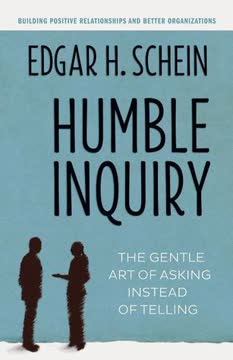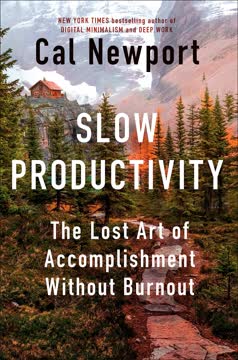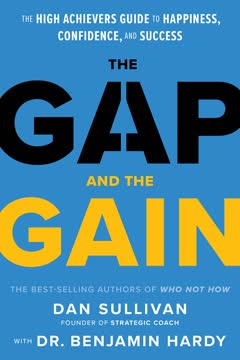Key Takeaways
1. The world is changing at an unprecedented pace, demanding constant adaptation
The slowest rate of change you will experience for the rest of your life is … right now.
Accelerating change. We are experiencing the greatest velocity of change in human history, driven by three interlocking "climate changes": technological, environmental, and economic. This rapid transformation is reshaping every aspect of our lives, from how we work and communicate to how we learn and create value.
Adaptation imperative. To thrive in this new reality, individuals and organizations must develop the capacity to adapt continuously. This means letting go of outdated mindsets, embracing new technologies, and being open to constant learning and reinvention. The ability to adapt is becoming our key advantage in navigating the uncertain future.
Key drivers of change:
- Exponential growth in technological capabilities
- Shifting cultural and social norms
- Globalization and interconnected economies
- Environmental challenges and sustainability concerns
2. Let go of fixed occupational identities to thrive in the future of work
Who are you if you are no longer a banker or a lawyer?
Identity flexibility. Our tight attachment to occupational identities can hinder our ability to adapt to rapidly changing work environments. Instead of defining ourselves by specific job titles or roles, we need to embrace a more fluid sense of professional identity based on our skills, values, and potential.
Reframing work identity. Focus on your "why" (purpose) and "how" (unique capabilities) rather than just your "what" (current job). This shift in perspective allows for greater adaptability and opens up new opportunities as the nature of work evolves. By detaching from rigid occupational labels, we become more resilient in the face of change and better positioned to seize emerging opportunities.
Steps to let go of fixed identities:
- Identify transferable skills and core competencies
- Explore diverse experiences and roles
- Cultivate a growth mindset
- Embrace lifelong learning and skill development
3. Develop an agile learning mindset to navigate continuous change
The ability to learn faster than your competitors may be the only sustainable competitive advantage.
Agile learning framework. An agile learning mindset consists of four key components: agency, agility, adaptability, and awareness. This mindset enables individuals to take ownership of their learning, quickly acquire new skills, adapt to changing circumstances, and maintain a keen understanding of themselves and their environment.
Continuous skill development. In a world where the half-life of skills is rapidly shrinking, the ability to learn, unlearn, and relearn becomes crucial. This involves not just acquiring new technical skills but also developing uniquely human capabilities such as creativity, empathy, and critical thinking. Organizations must shift from a focus on static knowledge to fostering a culture of continuous learning and adaptation.
Elements of an agile learning mindset:
- Agency: Taking responsibility for one's own learning and growth
- Agility: Quickly acquiring and applying new skills and knowledge
- Adaptability: Adjusting to new situations and challenges
- Awareness: Understanding oneself and the broader context of work and society
4. Embrace uniquely human skills to complement advancing technology
Humans need to understand what's computable. They don't need to understand a code, or to code, but they need to understand what's computable.
Human-technology synergy. As artificial intelligence and automation advance, the most valuable skills in the workplace will be those that are uniquely human. These include creativity, empathy, complex problem-solving, and social intelligence. By focusing on developing these skills, individuals can position themselves to work alongside and augment emerging technologies rather than compete with them.
Balancing technical and human skills. While digital literacy remains important, the ability to leverage uniquely human capabilities in conjunction with technological tools will be the key to success in the future workplace. This means cultivating a balance between technical proficiency and the soft skills that enable effective collaboration, innovation, and leadership.
Key uniquely human skills:
- Creativity and innovation
- Empathy and emotional intelligence
- Critical thinking and complex problem-solving
- Adaptability and resilience
- Leadership and collaboration
5. Leaders must foster psychological safety and cognitive diversity in teams
If you want something that grows, changes, explores, and pushes boundaries, there's just nothing in the fields of AI that does anything like that right now.
Psychological safety. Leaders play a crucial role in creating an environment where team members feel safe to take risks, share ideas, and admit mistakes. This psychological safety is essential for fostering innovation, learning, and adaptation in organizations. By modeling vulnerability and encouraging open communication, leaders can build trust and empower their teams to perform at their best.
Cognitive diversity. High-performing teams benefit from diverse perspectives and thinking styles. Leaders should actively seek out and value cognitive diversity, bringing together individuals with different backgrounds, experiences, and approaches to problem-solving. This diversity of thought leads to more creative solutions and better decision-making in complex, rapidly changing environments.
Strategies for fostering psychological safety and cognitive diversity:
- Encourage open dialogue and constructive dissent
- Celebrate failures as learning opportunities
- Build diverse teams with complementary skills and perspectives
- Create opportunities for cross-functional collaboration
- Provide regular feedback and recognition for innovative thinking
6. Culture and capacity are the cornerstones of adaptive organizations
Products are a souvenir of culture and evidence of your capacity.
Culture as foundation. An organization's culture provides the context in which adaptation and innovation can flourish. A strong, intentional culture aligned with the company's purpose and values creates a shared sense of identity and direction, even as specific roles and tasks evolve. Leaders must actively shape and reinforce this culture through their actions and decisions.
Capacity for change. Organizational capacity refers to the ability to respond to new opportunities and challenges. This involves not just having the right skills and resources but also the mindset and structures that enable rapid learning and adaptation. By focusing on building capacity rather than just capabilities, organizations can better navigate uncertainty and seize emerging opportunities.
Key elements of adaptive organizations:
- Clear purpose and values
- Emphasis on continuous learning and experimentation
- Flexible structures and processes
- Investment in employee development and wellbeing
- Data-driven decision-making and feedback loops
7. Hire for adaptability and cultural alignment, not just skills and experience
We need to consider learning agility, growth mindset, adaptability. These are aspects that we need to consider because I don't want to hire someone to do one job for the next two years; I want to hire them for the ability to do the next five jobs over the next 10 years, and I have no idea what those jobs are going to be.
Rethinking recruitment. Traditional hiring practices that focus solely on specific skills and past experience are becoming less relevant in a rapidly changing work environment. Instead, organizations should prioritize candidates who demonstrate adaptability, learning agility, and alignment with the company's culture and values.
Cultural add, not just fit. While cultural alignment is important, organizations should also seek diversity of thought and experience. The concept of "cultural add" emphasizes bringing in individuals who share core values but also contribute new perspectives and ideas. This approach helps prevent groupthink and fosters innovation within the organization.
Strategies for adaptive hiring:
- Assess learning agility and growth mindset
- Look for evidence of adaptability and resilience
- Evaluate cultural alignment and potential to contribute new perspectives
- Use scenario-based interviews to gauge problem-solving skills
- Consider non-traditional backgrounds and experiences
8. Continuous learning is the new pension in the evolving workplace
Learning becomes the new pension, accruing value all along the arc of your career.
Learning as investment. In a world where specific skills quickly become obsolete, continuous learning becomes essential for long-term career security. Just as pensions once provided financial security for retirement, ongoing skill development and adaptation now ensure employability and value creation throughout one's career.
Shared responsibility. Both individuals and organizations must prioritize continuous learning. Individuals should take ownership of their development, seeking out new opportunities to learn and grow. Organizations, in turn, should provide resources, time, and incentives for ongoing learning, recognizing it as a critical investment in their future success.
Approaches to continuous learning:
- Embrace a growth mindset and curiosity
- Seek out diverse experiences and challenges
- Engage in formal and informal learning opportunities
- Develop a personal learning network
- Practice reflection and self-assessment
- Leverage technology for on-demand learning
Last updated:
FAQ
1. What’s The Adaptation Advantage by Heather McGowan about?
- Future of work focus: The book explores how rapid technological, societal, and economic changes are transforming the workplace, emphasizing the need for continuous learning, unlearning, and adaptation.
- Human skills vs. automation: It argues that uniquely human skills—creativity, empathy, judgment, and collaboration—are essential for thriving in an era dominated by automation and AI.
- Practical frameworks: McGowan provides actionable frameworks for individuals and organizations to develop an agile learning mindset and build adaptive cultures.
- Leadership and identity: The book also addresses how leadership and professional identity must evolve to support ongoing adaptation and resilience.
2. Why should I read The Adaptation Advantage by Heather McGowan?
- Guidance for rapid change: The book offers a clear roadmap for navigating the unprecedented speed of technological, cultural, and market shifts.
- Emphasis on lifelong learning: It empowers readers to embrace ambiguity, vulnerability, and continuous reinvention as strengths for career and personal growth.
- Leadership and organizational insights: McGowan equips leaders with tools to foster cultures of psychological safety, cognitive diversity, and continuous learning.
- Relevance for all professionals: The advice is applicable to workers, managers, executives, educators, and students seeking to future-proof their skills and organizations.
3. What are the key takeaways from The Adaptation Advantage by Heather McGowan?
- Adaptability as a superpower: The ability to rapidly learn, unlearn, and adapt is the most sustainable competitive advantage for individuals and organizations.
- Letting go of fixed identity: Clinging to occupational identity limits growth; focusing on purpose and curiosity enables continuous reinvention.
- Agile learning mindset: Agency, agility, adaptability, and awareness are essential for thriving in a dynamic environment.
- Human skills are critical: Creativity, empathy, collaboration, and judgment are irreplaceable by machines and central to future success.
- Shift in organizational focus: Companies must move from scalable efficiency to scalable learning to keep pace with change.
4. What are the most important uniquely human skills highlighted in The Adaptation Advantage by Heather McGowan?
- Individual skills: Design mindset, novel and adaptive thinking, cognitive load management, and sensemaking are emphasized as vital for navigating ambiguity and complexity.
- Collaborative skills: Social intelligence, transdisciplinarity, cross-cultural competency, computational thinking, new media literacy, and virtual collaboration are highlighted.
- Empathy’s central role: Empathy is described as essential for innovation, wellness, and removing friction in high-touch jobs.
- Non-automatable advantage: These skills are difficult for machines to replicate, making them crucial for both human-to-human and human-to-machine collaboration.
5. How does Heather McGowan define and explain the “agile learning mindset” in The Adaptation Advantage?
- Four key components: The agile learning mindset includes agency (ownership of learning), agility (flexibility and responsiveness), adaptability (creating new approaches), and awareness (self and market understanding).
- Learning and unlearning: It stresses the importance of not just acquiring new skills, but also unlearning outdated knowledge and behaviors.
- Enabled by human skills: Social and emotional intelligence, creativity, and collaboration are foundational to this mindset.
- Essential for future work: This mindset is presented as the core enabler for continuous adaptation in a rapidly changing world.
6. What is the Iceberg Model in The Adaptation Advantage by Heather McGowan, and how does it relate to adaptation?
- Three skill layers: The Iceberg Model categorizes skills into explicit (visible), uniquely human (below the surface), and enablers (foundational attributes like mindset and identity).
- Role of enablers: Foundational enablers such as mindset and identity drive how individuals engage with learning and change.
- Agile learning at the base: The model highlights that adaptability, awareness, agency, and results agility are essential for continuous learning.
- Identity’s influence: Core and adaptive identities form the base, shaping openness to change and resilience.
7. How does The Adaptation Advantage by Heather McGowan describe the impact of technology on work and skills?
- Three forces at play: Atomization (breaking jobs into tasks), automation (machines doing predictable work), and augmentation (technology enhancing human abilities) are reshaping jobs.
- Jobs evolve, not vanish: While some tasks are automated, most jobs are transformed, requiring regular upskilling and reskilling.
- Human skills gain value: As routine tasks are automated, creativity, empathy, and judgment become more important.
- Collaboration with technology: Workers must learn to complement technology with uniquely human capabilities.
8. What role does professional identity play in adaptation according to The Adaptation Advantage by Heather McGowan?
- Identity as anchor and barrier: Professional identity provides self-esteem and social signals but can trap individuals in outdated roles.
- Fluid and evolving: Identity formation is ongoing and can be reshaped through narrative and exploration.
- Resilient identity supports learning: A secure, adaptive identity enables vulnerability and openness, which are necessary for continuous learning and reinvention.
- Purpose over job title: Focusing on purpose and passion rather than fixed roles supports adaptability.
9. What leadership practices and advice does Heather McGowan offer in The Adaptation Advantage for the future of work?
- Model vulnerability and trust: Leaders should demonstrate vulnerability, admit mistakes, and build psychological safety to foster innovation.
- Inspire and challenge: Creating a shared vision and encouraging experimentation helps teams embrace change.
- Enable collaboration: Leaders must foster environments where respectful dissent and risk-taking are encouraged.
- Celebrate and recognize: Recognizing contributions and celebrating accomplishments sustains motivation and engagement.
10. How does The Adaptation Advantage by Heather McGowan address organizational culture and capacity for adaptation?
- Culture as foundation: Organizational culture—intentional or accidental—shapes daily work life and adaptability.
- Capacity as organizational brain: Capacity includes mindset, learning agility, and the ability to leverage biases constructively.
- Inputs over outputs: Focusing on culture and capacity (inputs) is more important than just products and services (outputs) for thriving in change.
- Real-world examples: The book contrasts companies like Airbnb (intentional culture) and Uber (accidental culture) to illustrate the impact of culture on adaptability.
11. How does The Adaptation Advantage by Heather McGowan suggest rethinking hiring and building adaptive teams?
- Beyond job descriptions: Traditional job descriptions can limit adaptability; hiring should focus on values alignment and learning agility.
- Five talent types: The book identifies executive producer, transformational, contingent, rotational, and foundational talent as key contributors to adaptability.
- Cognitive diversity and safety: Successful teams combine diverse thinking styles with psychological safety for open idea expression.
- Continuous learning and fluid teams: Teams should embrace failure as a learning opportunity and operate in flexible, purpose-built groups.
12. What are the best quotes from The Adaptation Advantage by Heather McGowan and what do they mean?
- On human growth: “Human beings are works in progress that mistakenly think they're finished.” This underscores the necessity of embracing continuous growth and adaptation.
- On vulnerability: “Vulnerability is the birthplace of innovation, creativity and change.” Vulnerability is reframed as a strength essential for leadership and team trust.
- On learning: “The ability to learn faster than your competitors may be the only sustainable competitive advantage.” This highlights rapid learning as key to success.
- On culture and purpose: “People don't buy what you do, they buy why you do it.” This stresses the importance of purpose-driven culture for organizational success.
- On failure: “Failure is not a bug of learning, it's the feature.” This reframes failure as an essential and positive part of the learning and adaptation process.
Review Summary
The Adaptation Advantage receives mostly positive reviews, with readers praising its insights on navigating the future of work. Many appreciate the book's emphasis on adaptability, continuous learning, and developing uniquely human skills. Some found the concepts fresh and applicable, while others felt it was repetitive or geared towards specific industries. Criticisms include overreliance on diagrams and lack of practical implementation tips. Overall, reviewers recommend it for those interested in organizational transformation and preparing for a rapidly changing work environment.
Similar Books










Download PDF
Download EPUB
.epub digital book format is ideal for reading ebooks on phones, tablets, and e-readers.




